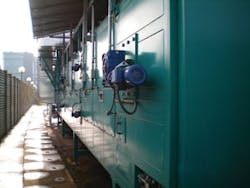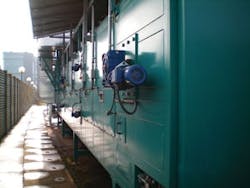Pollutants in aquifers threaten Mexico's 'Riviera Maya'
Feb. 6, 2011 -- Pharmaceuticals, illicit drugs, shampoo, toothpaste, pesticides, chemical run-off from highways and many other pollutants infiltrate the giant aquifer under Mexico's "Riviera Maya," research shows.
The wastes contaminate a vast labyrinth of water-filled caves under the popular tourist destination on the Yucatan Peninsula. The polluted water flows through the caves and into the Caribbean Sea. Land-sourced pollution may have contributed, along with overfishing, coral diseases, and climate change, to the loss since 1990 of up to 50% of corals on the reefs off the region's coast.
And, with a 10-fold increase in population through 2030 expected, the problems are likely to worsen, according to research published today in the journal Environmental Pollution.
"These findings clearly underline the need for monitoring systems to pin-point where these aquifer pollutants are coming from," says Trent University Prof. Chris D. Metcalfe, Senior Research Fellow of the United Nations University's Canadian-based Institute for Water, Environment and Health (UNU-INWEH).
"As well, prevention and mitigation measures are needed to ensure that expanding development does not damage the marine environment and human health and, in turn, the region's tourism-based economy."
Dr. Metcalfe conducted the study with Patricia A. Beddows of Northwestern University, Evanston IL, USA; Gerardo Gold Bouchot of CINVESTAV Unidad Merida. Mexico; Tracy L. Metcalfe and Hongxia Li of Canada's Trent University; and Hanneke Van Lavieren of UNU-INWEH. The work was conducted with the cooperation of a local non-governmental organization, "Amigos de Sian Ka'an."
The researchers concluded that illicit drugs, pharmaceuticals and personal care products found in the groundwater at four of the five locations originated from domestic sewage.
The illicit drugs identified were cocaine and its major post-digestion "metabolite" chemical, benzoylecgonine.
Also found were caffeine and a metabolite of nicotine and the ingredients of personal care products such as:
- Triclosan (an anti-bacterial agent used mainly in toothpaste, cleansers, and hand sanitizers);
- Synthetic musks (used in perfumes, deodorants, etc.);
- Non-prescription painkillers acetaminophen and ibuprofen.
The researchers point to pit latrines, septic tanks and leaking sewer lines as the pollution's likeliest points of origin, noting that just one-third of the state is served by municipal wastewater treatment systems.
Samples drawn near a golf course on a seaside resort, pointed to pesticide applications as another contamination source.
Polycyclic aromatic hydrocarbons (PAH) pollution, meanwhile, likely entered the groundwater as runoff from highways, parking lots, airport tarmac, and other solid surfaces.
Reverse osmosis systems for treating drinking water are widely used in the Riviera Maya, "but this technology is unlikely to remove all micro-contaminants," the study says.
While the levels of pollution found are not considered a health threat today, "the data provided in this study raise some concerns about the potential for human exposure from the consumption of contaminated drinking water."
The researchers note the area has "a general lack of expertise and equipment for monitoring or tracking sources of pollution," and "few administrative links between those responsible for water and coastal management and the labs that generate the (monitoring) data."
They recommend:
- Impermeable liners installed beneath golf courses and other areas that are extensively covered with turf to restrict the leaching of contaminants, nutrients and pathogens;
- Lined and impermeable drainage canals, retention ponds and treatment systems to deal with runoff in areas where liners have been installed;
- Adequate wastewater treatment infrastructure;
- A halt to injections of treated sewage into saltwater below the freshwater aquifer;
- Measures to avoid aquifer contamination from hard surface runoff;
- An integrated approach to coastal zone management; and
- Protection of all remaining mangroves, which buffer coastal areas from pollution.
They warn too that a combination of sea-level rise and over-extraction of freshwater contributes to saltwater intrusion into the aquifers, posing a threat to the region's freshwater quality and availability.
Without integrated approaches to protecting and managing the aquifer, "the tourism-based economy of the Maya Riviera region will not be sustainable over the medium to long term," the researchers conclude.
They deployed two types of passive sampling devices in five locations at depths of 1.5 to 10.5 meters to sample groundwater flowing under the area at a rate of 0.5 to 2.5 km per day to measure concentrations of contaminants and determine possible sources. The freshwater in these aquifers forms a distinct lens on top of intruding salt water. The two water layers meet and mix in these flooded cave systems, which extend 8 to 12 km inland.
The area's highly permeable geology, characterized by remarkable sinkholes offering access to the groundwater cave systems, makes the peninsula very susceptible to contamination.
"Diving down a sinkhole into these flooded cave systems was a truly unique experience - and slightly terrifying for someone diving in a cave for the first time," says Ms. van Lavieren, a programme officer at UNU-INWEH and trained rescue diver. "It is hard to imagine the actual size and shape of these cave systems without actually being in them. Thankfully, we were helped by experienced divers in the area to deploy and collect the passive samplers."
The study was part of UNU-INWEH's Caribbean Coastal Pollution Project (CCPP), started in 2007 to help build improved assessment, monitoring and management of Persistent Organic Pollutants (POPs) and Persistent Toxic Substances (PTS) in Caribbean coastal ecosystems.
Funded by the World Bank through Canada's Persistent Organic Pollutants Fund of the Canadian International Development Agency (CIDA), phase 1 of the project ended in mid-2010. The project covers eight countries, has developed a wide regional network of agencies, universities, labs and other institutions, developed a baseline monitoring programme for POPs, evaluated and upgraded environmental laboratories, trained lab staff, and implemented demonstration research projects to trace sources of contamination, which involved several graduate students from the region.
UNU-INWEH was established in 1996 to strengthen water management capacity, particularly of developing countries, and to provide on-the-ground project support. With core funding from the Government of Canada through CIDA, it is hosted by McMaster University, Hamilton, Canada
###

